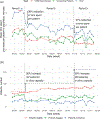Population-level management of type 1 diabetes via continuous glucose monitoring and algorithm-enabled patient prioritization: Precision health meets population health
- PMID: 34374183
- PMCID: PMC8635792
- DOI: 10.1111/pedi.13256
Population-level management of type 1 diabetes via continuous glucose monitoring and algorithm-enabled patient prioritization: Precision health meets population health
Abstract
Objective: To develop and scale algorithm-enabled patient prioritization to improve population-level management of type 1 diabetes (T1D) in a pediatric clinic with fixed resources, using telemedicine and remote monitoring of patients via continuous glucose monitor (CGM) data review.
Research design and methods: We adapted consensus glucose targets for T1D patients using CGM to identify interpretable clinical criteria to prioritize patients for weekly provider review. The criteria were constructed to manage the number of patients reviewed weekly and identify patients who most needed provider contact. We developed an interactive dashboard to display CGM data relevant for the patients prioritized for review.
Results: The introduction of the new criteria and interactive dashboard was associated with a 60% reduction in the mean time spent by diabetes team members who remotely and asynchronously reviewed patient data and contacted patients, from 3.2 ± 0.20 to 1.3 ± 0.24 min per patient per week. Given fixed resources for review, this corresponded to an estimated 147% increase in weekly clinic capacity. Patients who qualified for and received remote review (n = 58) have associated 8.8 percentage points (pp) (95% CI = 0.6-16.9 pp) greater time-in-range (70-180 mg/dl) glucoses compared to 25 control patients who did not qualify at 12 months after T1D onset.
Conclusions: An algorithm-enabled prioritization of T1D patients with CGM for asynchronous remote review reduced provider time spent per patient and was associated with improved time-in-range.
Keywords: continuous glucose monitoring; population management; remote monitoring.
© 2021 John Wiley & Sons A/S. Published by John Wiley & Sons Ltd.
Figures






Similar articles
-
A model to design financially sustainable algorithm-enabled remote patient monitoring for pediatric type 1 diabetes care.Front Endocrinol (Lausanne). 2022 Nov 11;13:1021982. doi: 10.3389/fendo.2022.1021982. eCollection 2022. Front Endocrinol (Lausanne). 2022. PMID: 36440201 Free PMC article.
-
Diabetes Technology Use in Remote Pediatric Patients with Type 1 Diabetes Using Clinic-to-Clinic Telemedicine.Diabetes Technol Ther. 2022 Jan;24(1):67-74. doi: 10.1089/dia.2021.0229. Diabetes Technol Ther. 2022. PMID: 34524007 Free PMC article.
-
Diabetes technology and treatments in the paediatric age group.Int J Clin Pract Suppl. 2011 Feb;(170):76-82. doi: 10.1111/j.1742-1241.2010.02582.x. Int J Clin Pract Suppl. 2011. PMID: 21323816 Review.
-
Adding glycemic and physical activity metrics to a multimodal algorithm-enabled decision-support tool for type 1 diabetes care: Keys to implementation and opportunities.Front Endocrinol (Lausanne). 2023 Jan 12;13:1096325. doi: 10.3389/fendo.2022.1096325. eCollection 2022. Front Endocrinol (Lausanne). 2023. PMID: 36714600 Free PMC article.
-
Monitoring of Pediatric Type 1 Diabetes.Front Endocrinol (Lausanne). 2020 Mar 17;11:128. doi: 10.3389/fendo.2020.00128. eCollection 2020. Front Endocrinol (Lausanne). 2020. PMID: 32256447 Free PMC article. Review.
Cited by
-
Teamwork, Targets, Technology, and Tight Control in Newly Diagnosed Type 1 Diabetes: the Pilot 4T Study.J Clin Endocrinol Metab. 2022 Mar 24;107(4):998-1008. doi: 10.1210/clinem/dgab859. J Clin Endocrinol Metab. 2022. PMID: 34850024 Free PMC article.
-
Stenopool: A Comprehensive Platform for Consolidating Diabetes Device Data.J Diabetes Sci Technol. 2024 Jul 23:19322968241264761. doi: 10.1177/19322968241264761. Online ahead of print. J Diabetes Sci Technol. 2024. PMID: 39044480 Free PMC article.
-
A Machine Learning Model for Week-Ahead Hypoglycemia Prediction From Continuous Glucose Monitoring Data.J Diabetes Sci Technol. 2025 Sep;19(5):1353-1361. doi: 10.1177/19322968241236208. Epub 2024 Mar 6. J Diabetes Sci Technol. 2025. PMID: 38445628 Free PMC article.
-
Equitable implementation of a precision digital health program for glucose management in individuals with newly diagnosed type 1 diabetes.Nat Med. 2024 Jul;30(7):2067-2075. doi: 10.1038/s41591-024-02975-y. Epub 2024 May 3. Nat Med. 2024. PMID: 38702523 Free PMC article.
-
A New Technology-Enabled Care Model for Pediatric Type 1 Diabetes.NEJM Catal Innov Care Deliv. 2022 May;3(5):10.1056/CAT.21.0438. doi: 10.1056/CAT.21.0438. Epub 2022 Apr 20. NEJM Catal Innov Care Deliv. 2022. PMID: 36544715 Free PMC article.
References
-
- Scheinker D, Gu A, Grossman J. Population-level personalized diabetes management facilitated by analyses of continuous glucose monitor data and telehealth visits: a prospective, non randomized trial. [published online ahead of print 2021]. JMIR Prepr 27284 2021; https://preprints.jmir.org/preprint/27284
Publication types
MeSH terms
Substances
Grants and funding
LinkOut - more resources
Full Text Sources
Medical
Miscellaneous

